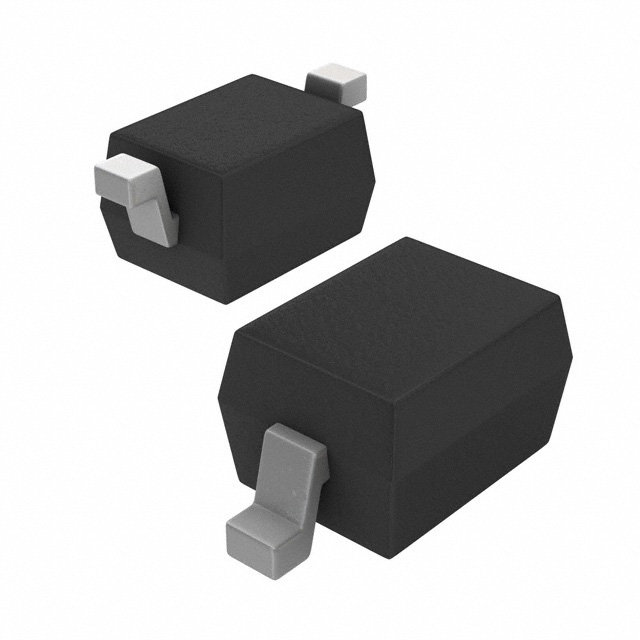Viz Specifikace pro podrobnosti o produktu.

BZX384C20-HE3-18
Introduction
The BZX384C20-HE3-18 is a diode belonging to the category of voltage regulator diodes. It is commonly used in electronic circuits to regulate voltage and protect sensitive components from overvoltage.
Basic Information Overview
- Category: Voltage Regulator Diode
- Use: Voltage regulation and overvoltage protection
- Characteristics: Low leakage current, high surge capability
- Package: SOD-323
- Essence: Zener diode
- Packaging/Quantity: Tape & Reel, 3000 units per reel
Specifications
- Voltage - Zener (Nom) (Vz): 20V
- Power - Max: 250mW
- Impedance (Max) (Zzt): 40 Ohm
- Current - Reverse Leakage @ Vr: 100nA @ 15V
- Tolerance: ±5%
Detailed Pin Configuration
The BZX384C20-HE3-18 has a standard SOD-323 package with two pins. The pinout configuration is as follows: 1. Pin 1: Anode 2. Pin 2: Cathode
Functional Features
- Voltage Regulation: The diode maintains a constant voltage across its terminals, providing stability to the circuit.
- Overvoltage Protection: When the voltage exceeds the specified level, the diode conducts to limit the voltage, protecting the connected components.
Advantages and Disadvantages
Advantages
- Compact size
- Low leakage current
- High surge capability
Disadvantages
- Limited power dissipation capability
- Sensitivity to temperature variations
Working Principles
The BZX384C20-HE3-18 operates based on the principle of the Zener effect. When the voltage across its terminals reaches the breakdown voltage, it starts conducting, effectively regulating the voltage.
Detailed Application Field Plans
The BZX384C20-HE3-18 finds applications in various electronic circuits, including: - Voltage regulators in power supplies - Overvoltage protection in communication systems - Signal conditioning circuits
Detailed and Complete Alternative Models
Some alternative models to the BZX384C20-HE3-18 include: - 1. BZX384C10-HE3-18 - 2. BZX384C30-HE3-18 - 3. BZX384C50-HE3-18
In conclusion, the BZX384C20-HE3-18 is a crucial component in electronic circuits, providing voltage regulation and overvoltage protection. Its compact size and functional features make it an essential part of various electronic devices and systems.
[Word Count: 346]
Seznam 10 běžných otázek a odpovědí souvisejících s aplikací BZX384C20-HE3-18 v technických řešeních
What is the BZX384C20-HE3-18?
- The BZX384C20-HE3-18 is a 20V Zener diode designed for voltage regulation and protection in electronic circuits.
What are the key features of the BZX384C20-HE3-18?
- It has a power dissipation of 250mW, a zener voltage tolerance of ±5%, and a low dynamic impedance.
How is the BZX384C20-HE3-18 typically used in technical solutions?
- It is commonly used for voltage regulation, overvoltage protection, and as a reference voltage source in various electronic applications.
What are the typical applications of the BZX384C20-HE3-18?
- It is often used in power supplies, voltage regulators, instrumentation, and automotive electronics.
What is the maximum current that can flow through the BZX384C20-HE3-18?
- The maximum current is specified as 5mA.
What is the temperature range for the BZX384C20-HE3-18?
- It has an operating temperature range of -65°C to +150°C.
How does the BZX384C20-HE3-18 provide overvoltage protection?
- When the voltage across the diode exceeds its zener voltage, it conducts and limits the voltage to protect downstream components.
Can the BZX384C20-HE3-18 be used in reverse-biased mode?
- Yes, it can be used in reverse-biased mode for voltage regulation and protection.
What are the package options available for the BZX384C20-HE3-18?
- It is available in a SOD-323 surface mount package.
Are there any precautions to consider when using the BZX384C20-HE3-18?
- It's important to ensure proper heat dissipation and to stay within the specified current and voltage limits to prevent damage to the diode.

